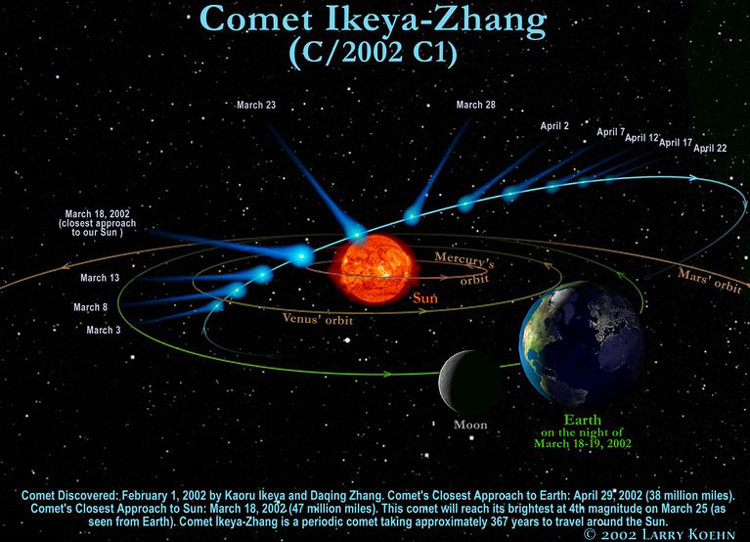|
The standard picture of the physical make-up of comets is one where the core, or nucleus, is composed of minute dust particles and assorted substances held together by water-ice and other ices. This model of cometary composition has become known as the “dirty snowball” theory, and came about in the 1940s. At that time, spectroscopic analysis of ‘the heads’ of comets, (which are extended balls of gas that grow around the nucleus of comets as they approach the sun) showed the presence of certain molecules derived from water (H2O), methane (CH4), ammonia (NH3) and carbon dioxide (CO2).
The term “dirty snowball” was coined by an American astronomer, Fred L. Whipple, in 1949, though the idea that comets were made of ice goes back
to Laplace in the 19th century, and
neither is it the only model of cometary composition that exists. The Giotto spacecraft, which was one of several spacecraft which flew close to Halley’s Comet in March 1986, sent back images which suggested that many larger rocks were also present, and that the nucleus of a comet is better viewed as an “icy rock pile” than a “dirty snowball”. But even this model has been challenged, and there is emerging a large school of thought which favours the idea that the centre of the nucleus of comets may in fact be a ‘warm liquid core’ in which organic molecules and even complex compunds, including live viruses, thrive.
Increasingly, as technological advances allow more and more cometary and solar system dust particles to be gathered and analysed, astronomers and astro-physicists are warming to the ideas of “Panspermia”, as organic molecules are retrieved in meteor showers by high altitude balloons as well as in near-earth space. The theory of panspermia holds that ‘life’ is transported and spread throughout the universe by comets which crash into rocky bodies, such as our moon is now, and thereby deliver the water, gasses and organic matter necessary for ‘life’ to get started.
As comets approach the Sun the ices begin to vaporise in the increasing heat, and along with small bits of dust particles begin to form the spectacular tails that can be seen from the Earth. These ‘tails’ are in reality ‘trails’ or ‘streams’, and periodically the orbit of the Earth intersects the orbital paths of the various cometary debris trails.
When this occurs the bits in these ‘trails’ and ‘streams’ enter the Earth’s atmosphere and burn up creating the shooting-star phenomena known as ‘meteor showers’. The same phenomena occurs when the Earth’s orbital path encounters inter-planetary dust clouds, which can also contain much larger bodies composed of metal and rock.
For example, on February 28 1998, the periodic comet Temple-Tuttle was at its closest point to the Sun, and even though it has now moved away again it left behind a trail, or cloud, of debris which has been added to that left by previous passages of this comet through our
solar system. The Earth passes through this trail of cometary debris each November 15th to 21st, and as the resulting ‘shooting stars’ appear to be coming from the direction of the constellation Leo they are known as the ‘Leonid meteor shower’. It has been one of the best observed meteor showers for over
1000 years.
Because the Earth passed very close to the orbital path of comet
Tempel-Tuttle in 1998 and 1999 the meteor showers were expected to be more spectacular than in most years, and be more like a ‘meteor storm‘. In fact the Earth passes this close only every 33 years, and rather than the usual annual 10 to 15 meteors per hour seen most Novembers, in 1999 they were expected to increase to anywhere from 200 to 15,000 meteors
per hour, and the same number was expected in 2000. As it turned out the ‘peaks’ were not all that spectacular, but predictions by astronomers at Armagh Observatory in the north of Ireland were that the Earth’s passages through this debris stream in
2001 and
2002 could produce ‘shooting stars’ numbering around 10,000 to 100,000 at the peaks in those two years.
However, since that last major Earth orbit encounter with the greatest concentration of Leonid cometary debris in 1966, many more satellites have been launched into space, and there was growing concern that some the dust particles could literally ‘sand blast’ them into oblivion. The speed of these particles varies, but can be as much as 155,000 miles per hour which is a hundred times faster than a bullet, and could cause major damage to satellites which are not protected by the Earth’s atmosphere.
On April 27 and 28 1998, in Manhatten Beach, California, the “Leonid Meteoroid Storm and Satellite Threat Conference” was held. A few weeks later William H. Ailor, Ph.D. was one of several experts who gave testimony before the US House of Representatives. He is the Director of the Center for Orbital and Re-entry Debris Studies.
Before the Committee on Science, Subcommittee on Space and Aeronautics Hearing on “Asteroids: Perils and Opportunities”, on May 21 1998, the discussion explored the dangers to telecommunications, the Global Positioning System which many ships rely on for directions in cloudy weather, and also on what lessons could be learned for the future. The main focus was on what was then
“The Upcoming Leonid Meteoroid Storm and its Effect on Satellites”.
Since these conferences and subcommittee hearings, major advances have been made in the ability of astronomers to predict the exact timing of the ‘peaks’ in meteor activity of the Leonid meteor showers by astro-physicist, David Asher, of Armagh Observatory in the north of Ireland. Working with Robert McNaught of the Australian National University, they predicted that the 1999 Leonids would ‘peak’ at 02:08 am on the morning of November 18. The actual peak was in fact just a few minutes earlier, and they successfully predicted the times of the several ‘flurries of shooting-stars’ for November 16 through 18 in 2000.
For November 18/19 2001, the Asher/McNaught model predicted around 10,000 meteors per hour (ZHR) as our planet encounters the clouds of cometary debris laid down when the comet 55P/Tempel-Tuttle passed through the solar system in the years 1767 and 1866. In 2002 our planet will pass directly through the middle of these same two dust clouds in the early hours of November 19th – just two of the many dust clouds that make up the ‘Leonid Complex’.
Comets sometimes disintegrate during their passage through our solar system, and in July 1992 the comet
Shoemaker-Levy 9 did just that as it appeared to be in termporary orbit around Jupiter. Splitting into more than 20 large fragments, which impacted on the surface of Jupiter from July 16 to 22nd 1994, they were watched with awe by astronomers on Earth, and for the first time the fragility of our own planet began to really sink in as scientists and the public at large began to ask the inevitable question:
“what could have happened if those massive chunks of
cometary debris had impacted the Earth instead?”
|
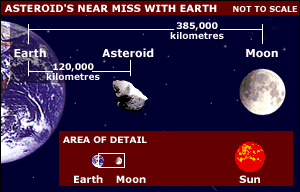
copyright © 2002 BBC News Online
|
|
Besides the comets, which enter our solar system in a variety of ways, there are also many other Near Earth Objects (NEOs) such as the
asteroids in our solar system which have the potential for becoming dislodged from their orbits, and heading onto collision courses with the Earth and other inner planets.
|
The near miss of asteroid 2002 MN on June 14 was the closest recorded by astronomers since asteroid 1994 XM1 came slightly closer eight years ago.
In recognition of this threat there has been increasing concern over the past twenty years, and even before the impacts of cometary fragments on Jupiter in July 1994 NASA held a ‘Near-Earth-Object Detection Workshop’ which discussed these problems in January 1992. Topics for ranged from “Hazard of Cosmic Impacts” and “The Near-Earth-Object Population”, to ideas and proposals for a ‘Search Stategy’ and follow-up observations. The workshop concluded with calls for International co-operation, and plans were laid for what has since become known as
“The Spaceguard Survey”.
Since the 1992 Nasa workshop on NEOs there have been many other organisations setting up research projects, and planetary defence worshops. A number of new organisations have come into being to compliment the work already being done by long established universities, observatories – including infra-red satellite detection – and a wide variety of independent researchers. There is also
2025, a study designed to comply with a directive issued by the chief of staff of the US Air Force.
So great had the concern about ‘impact probability’ estimates grown by this time, that an International Spaceguard Workshop was held at the beginning of June 1999 in Torino, Italy. In attendance were many of those who are directly concerned on a daily basis with the ‘impact hazard’, ranging from astro-physicists to those involved with commercial and military satellite operations. What resulted from the workshop was the creation of the
Torino Scale, which has been described on the Nasa Impact Website in the following words:
“The Torino Scale is a ‘Richter Scale’ for categorizing the Earth impact hazard associated with newly discovered asteroids and comets.”
|
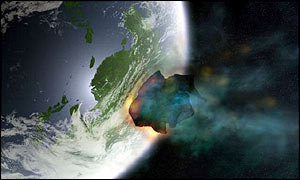
copyright © 2002 BBC News Online
|
|
In January 2000 Lord Sainsbury, the Minister for Science, made an announcement regarding the setting up of a Task Force to look into the hazard from Near Earth Objects (NEO’s).
The Task Force reported back to the UK Govt. on September 18 2000, and the full report is available online here
|
Serious and sensible reactions and comments regarding this report from the international astronomical community have been archived on the Cambridge Conference Network (CCNet). More info is available at SpaceGuard UK
On October 3, 2002, the United States House Committee on Science met to hear testimony about the ‘impact threat’ from asteroids, cometary debris and other celestial bodies. The testimony given before the House Committee by a number of leading authorities in the fields of astronomy and planetary defence are accessible directly below:
-
Brian G. Marsden, Director, Minor Planet Center
(only available in .pdf format)
-
Brigadier General Simon P. Worden, Deputry Director for Operations, United States Strategic Command
-
Dr. David Morrison, Ames Research Center, NASA
-
Dr. Edward J. Weiler, Associate Administrator for Space Science, NASA
-
Joseph A. Burns, Ph.D., Professor of Astronomy, Cornell University
In the light of recent media coverage of the threat to life on our planet posed by Near Earth Objects (NEOs) such as asteroids and comets, Jonathan (Jay) R. Tate of The Spaceguard Centre in Powys, Wales, convened an informal meeting of those who provide information on NEOs, and those who report the news to the general public. The aim of the meeting was for participants to exchange experiences and views on this important subject in order to increase everyone’s understanding of the issues involved, and the ways in which it is, or should be, responsibly reported to the public at large. The report of the symposium is available below.
NEO Public Awareness Symposium – October 13th 2003
Since the NEO Public Awareness Symposium at the International SpaceGuard Information Centre, in Knighton, Powys, CYMRU/WALES, there has been a rapidly increasing interest in developing mitigation strategies for cosmic bodies found to be on collision courses with the Earth. Links to them appear below:
2004 Planetary Defense Conference:
Protecting Earth from Asteroids – February 23-26, 2004
2007 Planetary Defense Conference:
March 5-8, 2007
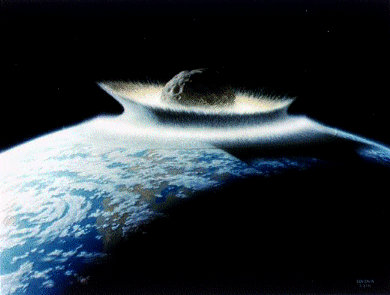
a painting by Donald E. Davis for NASA
SpaceGuard Organisations
There are a number of SpaceGuard organisations around the world that have been set up over recent years. Most are affiliated to the International SpaceGuard Foundation based in Rome. Each of these organisations have developed links with researchers in universities and non-profit research groups in their respective areas, and between them their web-sites contain the most comprehensive links to all these other organisations
-
The International Spaceguard Foundation
-
The International Spaceguard Information Centre
-
Spaceguard UK
-
Australian Spaceguard Survey
-
Minor Planet Centre
-
Japan Spaceguard Association
-
The Planetary Society
|
|
Halleys Comet, 1986
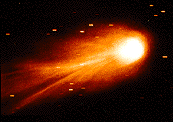
Halley’s comet is probably the best known of all the comets that pass periodically through our solar sytem. It was in 1705 that Edmond Halley first predicted it would return after his death in 1758, and so took his name.
It’s orbit is inclined at 18 degrees to the ecliptic, and the major planets in our solar system exert such a gravitational pull on it that its orbital period varies slightly between 76.3 years (as it was in 1066) and 76.0 years (as it was in 1986).
Comet P/Shoemaker-Levy
9 collides with Jupiter
in July 1994

Between the dates of July 16th. and July 22nd. 1994 the comet, Shoemaker/Levy 9, broke into 21 fragments as it headed on a collision course with the planet Jupiter. These fragments varied in size, but many of them were up to 2Km in diameter.
This was the first time that ‘a collision between two bodies in our solar system’ has been observed by modern astronomers, and there are many more images like the one to the left to be seen by clicking on the image/link to the left.
Comet Hale-Bopp
Spring Equinox 1997
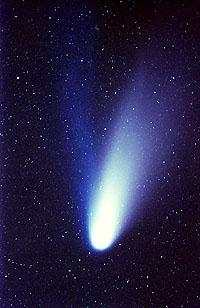
In 1997 the comet Hale-Bopp passed through our solar system. It was visible from many locations around the world, and the image to the left was taken by the Nasa Jet Propulsion Lab on the Spring Equinox, March 21st 1997.
Its orbital period is around 4,000 years and does not threaten to collide with any other body in our solar system. You can access many more images of comet Hale-Bopp at the JPL site.
Books about asteroids,
comets, meteor storms
& ancient catastrophes

“Natural Catastrophes During Bronze Age Civilisations”
(British Archaeological Reports)
Benny J. Peiser, Trevor
Palmer, Mark E. Bailey
(Editors)
EU English Edition only
but available
worldwide
Research in the field of neo-catastrophism and impact cratering has quickened its pace since the early 1980s. Scholars such as Victor Clube, Bill Napier, Mark Bailey, Sir Fred Hoyle and Duncan Steel claim that a more ‘active’ sky might have caused major cultural changes of Bronze Age civilizations, belief systems and religious rituals.”
“Rogue Asteroids and
Doomsday Comets
Duncan Steel
(Author)
Arthur C. Clarke
(Foreword)

EU English Edition
“Could both Stonehenge and the pyramids of Egypt have been constructed to observe and commemorate a period of phenomenal meteor storms and asteroid detonations produced by a burst of activity in the Taurid Complex 4,500 to 5,000 years ago? Author Duncan Steel examines the evidence indicating rogue asteroids and doomsday comets may have been behind these and other ancient phenomena.”
“Exodus to Arthur:
Catastrophic Encounters
with Comets”
Mike Baillie

EU English Edition
“Based on the scientific analysis of tree rings, this text argues that the Earth has undergone several catastrophic encounters with comets and their debris in the last five millennia, with mythology preserving the story better than history. It reveals extraterrestrial bombardment events.
This intriguing challenge to traditional views of history, provides explanations for many of the myths and legends that continue to haunt humankind. In particular, it argues that, in the last five millennia, the Earth has undergone several catastrophic encounters with comets and their debris–and that mythology has preserved these events better than so-called “factual” records.”
“The Celtic Gods: Comets in
Irish Mythology”
Mike Baillie
&
Patrick McCafferty
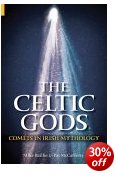
EU English Edition
“The Celtic myths, involving heroic warriors such as Finn and CuChulinn, can be read as simple primitive stories, but closer examination reveals strange descriptions and relationships.
The authors of this ground-breaking book argue that all the principal characters are aspects of the one Celtic sky god, Lugh, who was a comet. Against the background of a comet scenario this re-interpretation of about ten key Celtic myths shows how many of the descriptions in the myths fit the appearance of comets.
The fact that these comets on occasions produced abrupt environmental changes, that can be traced in the tree-ring and ice-core chronologies, pins the stories to a central reality. With a novel twist this original book confirms the widespread belief that these stories must contain a ‘core of truth’.”
|


